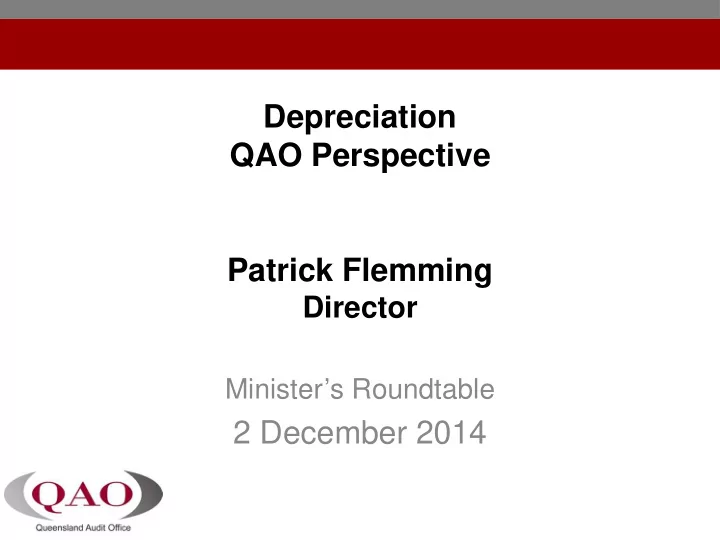

Depreciation QAO Perspective Patrick Flemming Director Minister’s Roundtable 2 December 2014
Starting position • This is not a new approach to depreciation • We are not advocating manipulation of figures to derive false depreciation outcomes • Changing figures in financial statements cannot make a council more sustainable • There is a need to better understand business and ensure reflection in financial statements • Better asset management planning will drive better business decisions
Asset valuations observations Significant volatility in valuations: • incomplete or inaccurate underlying asset component data • valuation and depreciation treated purely as a financial reporting process rather than reflecting council’s anticipated asset management practices • changing methodologies and assumptions inappropriately to derive a particular financial statement outcome • apply unrealistic assumptions in valuation and depreciation calculations.
Asset valuations observations • Councils should obtain sufficient evidence to support the key inputs and assumptions used in determining asset values – condition assessments – unit rates – useful lives – residual values – depreciation method – appropriateness of indices • Ensure consistency with actual maintenance and replacement strategies as per asset management plans • Align financial data with engineering data
Defining the problem • Depreciation is just the outcome it is not the source of the ‘financial sustainability’ problem • Based on assumptions – it is an estimate • Do the assumptions reflect reality? • Collaboration between accountants & engineers • Look at other impacts: – E.g. capital versus repairs and maintenance
Accounting policies • Routine operating maintenance, repair costs and minor renewals to maintain the operational capacity of the non current asset is expenses as incurred, while expenditure that relates to replacement of a major component of an asset to maintain its service potential is capitalized • Depreciation methods, estimated useful lives and residual values of PP&E are reviewed at the end of each reporting period and adjusted where necessary to reflect any changes in the pattern of consumption, physical wear and tear, technical or commercial obsolescence or management intentions. Condition assessments are used to estimate useful lifes.
Applying the cost approach - principles • current replacement cost – the amount that would be required currently to replace the service capacity of an asset • adjusted for obsolescence: – physical deterioration – functional (technological) – external (economic) obsolescence
Adjusted for obsolescence • Physical obsolescence – physical deterioration of an asset or its components resulting from its age and normal usage. • Functional obsolescence – inefficiencies in the subject asset compared to its replacement - two forms: changes in design, materials, technology or manufacturing/construction techniques resulting modern equivalent assets with lower capital costs than the subject asset improvements in design or excess capacity resulting in modern equivalent assets with lower operating costs than the subject asset • External obsolescence – loss of utility value caused by economic or locational factors external to the asset – economic obsolescence when the external factors relate to changes in supply or demand for the asset or for products or services produced by the asset – external obsolescence adjustment is deducted after physical deterioration and functional obsolescence
Case study: schools in Victoria • valued on a DRC basis - by 30 June 2013 write down carrying values of school buildings by $1.5 billion • current replacement cost - based on the size of school that would be required using the higher of current student enrolments or forecast long-term enrolments. • premise - would not replace the existing area of a school if the current or forecast future student enrolments do not support a school of the current size and so is considered to be economically obsolete
Case study – reasons for qualification • relies solely on the number of students enrolled – ignores other services that the school currently facilitates—such as before and after school care programs – ignores common areas used by children regardless of how many students there are (eg assumes that children do not need 26 per cent of a library or gym). • unable to fully support the assumptions and judgements used in the calculation (reliable measurement)
Principles Asset measurement
Principles: segmentation Source: Guide to Asset Management Part 8: Asset Valuation and Audit, Austroads, 2009
Principles: componentisation Source: Guidelines for measuring and reporting the condition of road assets (May 2006), Local Government Victoria
Depreciation of roads example Example of depreciation of a sealed road by components Source: Guidelines for measuring and reporting the condition of road assets (May 2006), Local Government Victoria
Depreciation of pipes example
Depreciation of pipes example
Depreciation of pipes example
Recommend
More recommend